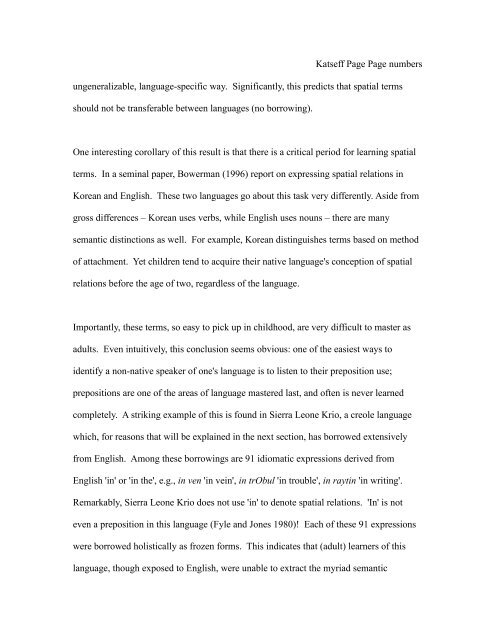The case of pidgin and creole languages - Linguistics
The case of pidgin and creole languages - Linguistics
The case of pidgin and creole languages - Linguistics
Create successful ePaper yourself
Turn your PDF publications into a flip-book with our unique Google optimized e-Paper software.
Katseff Page Page numbers<br />
ungeneralizable, language-specific way. Significantly, this predicts that spatial terms<br />
should not be transferable between <strong>languages</strong> (no borrowing).<br />
One interesting corollary <strong>of</strong> this result is that there is a critical period for learning spatial<br />
terms. In a seminal paper, Bowerman (1996) report on expressing spatial relations in<br />
Korean <strong>and</strong> English. <strong>The</strong>se two <strong>languages</strong> go about this task very differently. Aside from<br />
gross differences – Korean uses verbs, while English uses nouns – there are many<br />
semantic distinctions as well. For example, Korean distinguishes terms based on method<br />
<strong>of</strong> attachment. Yet children tend to acquire their native language's conception <strong>of</strong> spatial<br />
relations before the age <strong>of</strong> two, regardless <strong>of</strong> the language.<br />
Importantly, these terms, so easy to pick up in childhood, are very difficult to master as<br />
adults. Even intuitively, this conclusion seems obvious: one <strong>of</strong> the easiest ways to<br />
identify a non-native speaker <strong>of</strong> one's language is to listen to their preposition use;<br />
prepositions are one <strong>of</strong> the areas <strong>of</strong> language mastered last, <strong>and</strong> <strong>of</strong>ten is never learned<br />
completely. A striking example <strong>of</strong> this is found in Sierra Leone Krio, a <strong>creole</strong> language<br />
which, for reasons that will be explained in the next section, has borrowed extensively<br />
from English. Among these borrowings are 91 idiomatic expressions derived from<br />
English 'in' or 'in the', e.g., in ven 'in vein', in trObul 'in trouble', in raytin 'in writing'.<br />
Remarkably, Sierra Leone Krio does not use 'in' to denote spatial relations. 'In' is not<br />
even a preposition in this language (Fyle <strong>and</strong> Jones 1980)! Each <strong>of</strong> these 91 expressions<br />
were borrowed holistically as frozen forms. This indicates that (adult) learners <strong>of</strong> this<br />
language, though exposed to English, were unable to extract the myriad semantic

















